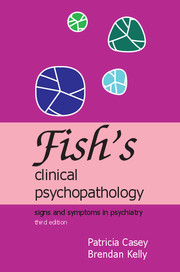Book contents
- Frontmatter
- Contents
- The authors
- Preface
- 1 Classification of psychiatric disorders
- 2 Disorders of perception
- 3 Disorders of thought and speech
- 4 Disorders of memory
- 5 Disorders of emotion
- 6 Disorders of the experience of self
- 7 Disorders of consciousness
- 8 Motor disorders
- 9 Personality disorders
- Appendix I Psychiatric syndromes
- Appendix II Defences and distortions
- Index
2 - Disorders of perception
Published online by Cambridge University Press: 15 February 2018
- Frontmatter
- Contents
- The authors
- Preface
- 1 Classification of psychiatric disorders
- 2 Disorders of perception
- 3 Disorders of thought and speech
- 4 Disorders of memory
- 5 Disorders of emotion
- 6 Disorders of the experience of self
- 7 Disorders of consciousness
- 8 Motor disorders
- 9 Personality disorders
- Appendix I Psychiatric syndromes
- Appendix II Defences and distortions
- Index
Summary
Disorders of perception can be divided into sensory distortions and sensory deceptions. In distortions there is a constant real perceptual object, which is perceived in a distorted way, while in sensory deceptions a new perception occurs that may or may not be in response to an external stimulus.
Sensory distortions
These are changes in perception that are the result of a change in the intensity and quality of the stimulus or the spatial form of the perception.
Changes in intensity (hyper- or hypo-aesthesia)
Increased intensity of sensations (hyperaesthesia) may be the result of intense emotions or a lowering of the physiological threshold. Thus a person may see roof tiles as a brilliant flaming red or hear the noise of a door closing like a clap of thunder. Anxiety and depressive disorders as well as hangover from alcohol and migraine are all associated with increased sensitivity to noise (hyperacusis) so that even day-to-day noises such as washing crockery are magnified to the point of discomfort. Those who are hypomanic, suffering an epileptic aura or under the influence of lysergic acid diethylamide (LSD) may see colours as very bright and intense, but this can also be a feature of intense normal emotions such as religious fervour or the unsurpassed happiness of being in love.
Hypoacusis occurs in delirium, where the threshold for all sensations is raised. The defect of attention found in delirium further reduces sensory acuity. This highlights the importance of speaking to the delirious patient more slowly and louder than usual. Hypoacusis is also a feature of other disorders associated with attentional deficits such as depression and attention-deficit disorder. Visual and gustatory sensations may also be lowered in depression, for example, everything is black or all foods taste the same.
Changes in quality
It is mainly visual perceptions that are affected by this, brought about by toxic substances. Colouring of yellow, green and red have been named xanthopsia, chloropsia and erythropsia. These are mainly the result of drugs (for example, santonin, poisoning with mescaline or digitalis) used in the past to treat various disorders. The qualitative change most associated with drugs now is the metallic taste associated with the use of lithium, although this is not a hallucination but a true change in gustation. In derealisation everything appears unreal and strange, while in mania objects look perfect and beautiful.
- Type
- Chapter
- Information
- Fish's Clinical PsychopathologySigns and Symptoms in Psychiatry, pp. 14 - 31Publisher: Royal College of PsychiatristsPrint publication year: 2007



